Assignment:
Part 1
1- A copper wire has a diameter dCu = 0.0470 cm, is 3.00 m long, and has a density of charge carriers of 8.50 x1028 electrons/m3. As shown in the figure, the copper wire is attached to an equal length of aluminum wire with a diameter dAl = 0.0110 cm and density of charge carriers of 6.02 x1028 electrons/m3. A current of 0.470 A flows through the copper wire.
(a) What is the ratio of the current densities in the two wires, JCu/JAl?
(b) What is the ratio of the drift velocities in the two wires, vd-Cu/vd-Al?

2- As illustrated in the figure, a current, i, flows through the junction of two materials with the same cross-sectional area and with conductivities σ1 and σ2. Show that the total amount of charge at the junction is ε0i(1/σ2 - 1/σ1).

3- A 10-gauge copper wire, with a constant potential difference of 0.4 V applied across its 1 m length at room temperature (20° C), is cooled to liquid nitrogen temperature (77 K = -196 °C). (The resistivity and temperature coefficient of resistivity of copper are 1.72 10-8 m Ω and 3.9 10-3 K-1, respectively.)
(a) Determine the percentage change in the wire's resistance during the drop in temperature.
(b) Determine the percentage change in current flowing in the wire.
(c) Compare the drift speeds of the electrons at the two temperatures. (Copper has 1 conducting electron per atom.)
4- What is the equivalent resistance of the five resistors in the circuit in the figure? Let R1 = 28 Ω, R2 = 56 Ω, R3 = 84 Ω, R4 = 112 Ω, R5 = 140 Ω. (When entering units, use ohm for Ω.)
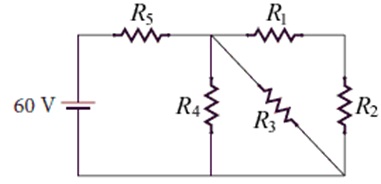
5- A potential difference of V = 0.550 V is applied across a block of silicon with resistivity 8.70 10-4 Ω m. As indicated in the figure, the dimensions of the silicon block are width a = 2.00 mm and length L = 18.5 cm. The resistance of the silicon block is 50.0 Ω, and the density of charge carriers is 1.23 1023 m-3. Assume that the current density in the block is uniform and that current flows in silicon according to Ohm's Law. The total length of 0.500-mm-diameter copper wire in the circuit is 78.0 cm, and the resistivity of copper is 1.69 10-8 Ω m.
(a) What is the resistance, Rw, of the copper wire?
(b) What are the direction and the magnitude of the electric current, i, in the block? (Indicate the direction in the block as displayed in the figure above.)
(c) What is the thickness, b, of the block?
(d) On average, how long does it take an electron to pass from one end of the block to the other?
(e) How much power, P, is dissipated by the block? (f) In what form of energy does this dissipated power appear?
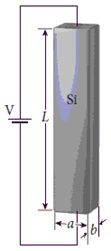
Part 2
1- Find the equivalent resistance for the circuit in the figure. (Use the following as necessary: Vemf, R.)
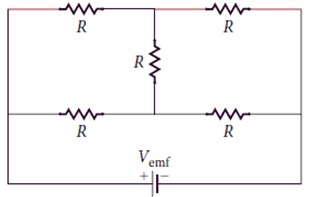
2- The dead battery of your car provides a potential difference of 9.630 V and has an internal resistance of 1.150 Ω. You charge it by connecting it with jumper cables to the live battery of another car. The live battery provides a potential difference of 12.00 V and has an internal resistance of 0.0100 Ω, and the starter resistance is 0.0700 Ω.
(a) Draw the circuit diagram for the connected batteries. (The starter is in parallel with the live battery.) (Do this on paper. Your instructor may ask you to turn in this work.)
(b) Determine the current in the live battery, in the dead battery, and in the starter immediately after you closed the circuit.
3- The circuit shown in the figure consists of two batteries with VA = 6.3 V and VB = 12.1 V and three light bulbs with resistances R1, R2, and R3. Calculate the magnitudes of the currents i1, i2, and i3 flowing through the bulbs.
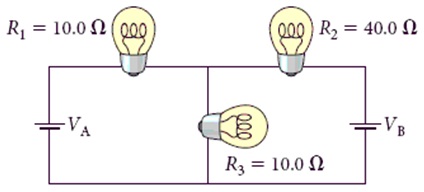
4- A circuit consists of two 3.45-kΩ resistors in series with an ideal 12.0-V battery.
(a) Calculate the current flowing through each resistor.
(b) A student trying to measure the current flowing through one of the resistors inadvertently connects an ammeter in parallel with that resistor rather than in series with it. How much current will flow through the ammeter, assuming that it has an internal resistance of 2.5 Ω?
5- What is the time constant for the discharging of the capacitors in the circuit shown in the figure? If the 2-µF capacitor initially has a potential difference of 63 V across its plates, how much charge is left on it after the switch has been closed for a time equal to half of the time constant?
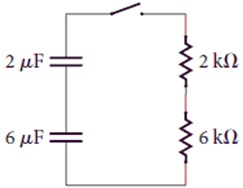
6- A 6.0-V battery is attached to a 6-mF capacitor and a 440-Ω resistor. Once the capacitor is fully charged, what is the energy stored in it? What is the energy dissipated as heat by the resistor as the capacitor is charging?